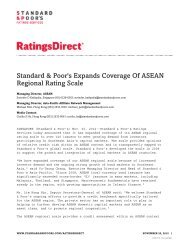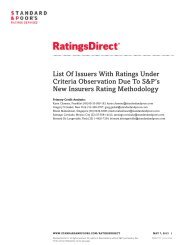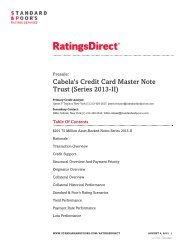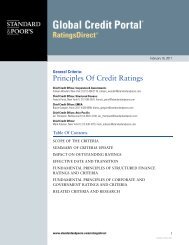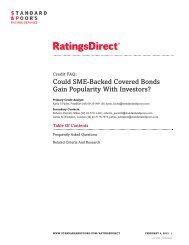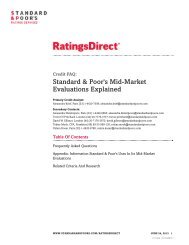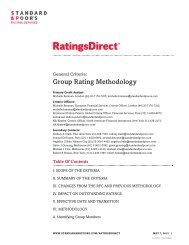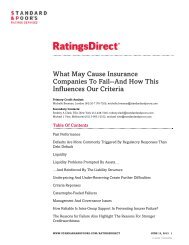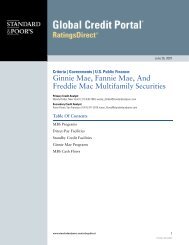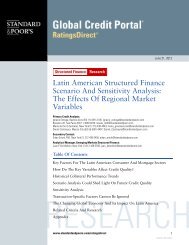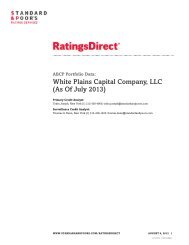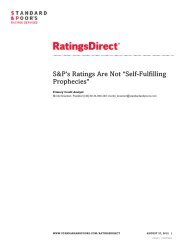Bank Ratings Incorporate Expectations For ... - Standard & Poor's
Bank Ratings Incorporate Expectations For ... - Standard & Poor's
Bank Ratings Incorporate Expectations For ... - Standard & Poor's
Create successful ePaper yourself
Turn your PDF publications into a flip-book with our unique Google optimized e-Paper software.
the buyback of debt instruments. We estimate that the two measures together would enhance the bank RAC's ratio<br />
by about 65 basis points. In addition, as of Jan. 31, 2012, Zuercher Kantonalbank successfully completed the<br />
issuance of Swiss franc (CHF) 590 million in Tier 1 subordinated debt, which we include in our TAC, and which we<br />
believe would likely enhance the bank's RAC ratio by about 100 basis points.<br />
Another bank that has substantially increased capital since September 2011 is Santander. Based on the bank's<br />
reported figures as of year-end 2011, we believe that its RAC ratio should have improved by at least 50 basis points<br />
in fourth-quarter 2011. The bank took several initiatives in the fourth quarter to comply with the EBA's core capital<br />
requirements in advance of the June 2012 deadline. Some of those, in particular the extension of the scrip dividend<br />
program and a reduction in the amount of goodwill and other intangibles, should have a positive impact on our<br />
year-end 2011 RAC. However, other measures aimed at converting Tier 1 instruments into core capital were neutral<br />
to our RAC because we already gave full credit in our RAC to the hybrids subject to the exchange.<br />
In addition, UBS substantially deleveraged market risk exposures in the fourth quarter of 2011. On a pro forma<br />
basis, we estimate that the RAC ratio was close to or within the 7%-8% range at year-end 2011. <strong>Bank</strong> of America<br />
(BofA) also increased its RAC ratio meaningfully during the fourth quarter as a result of a number of significant<br />
capital actions. We estimate that the RAC ratio should have improved by about 90 basis points. Actions taken<br />
during the quarter included an exchange of preferred and trust preferred securities for common stock and senior<br />
notes. The company also sold its investment in China Construction <strong>Bank</strong> (CCB). Also during the quarter, BofA<br />
reduced its RWA by a reported $75 billion through the sale of noncore assets and other management actions. In<br />
2012, KBC finalized the signed agreements to sell Warta, KBL, and Fidea, which we believe will increase KBC's<br />
RAC ratio by about 50 basis points.<br />
Another example of a bank with a RAC ratio currently lower than its capital and earnings assessment would imply<br />
is VTB <strong>Bank</strong>. VTB's RAC ratio dropped to an estimated 3.8% as of Sept. 30, 2011, from 6.9% at year-end 2010<br />
because of the bank's third-quarter 2011 purchase of <strong>Bank</strong> of Moscow (BOM) under fair value accounting. The<br />
acquisition increased VTB's risk-weighted assets and reduced its tangible equity because of an increase in goodwill.<br />
Just prior to the purchase, the Russian government took the troubled BOM under administration and injected $5<br />
billion, increasing BOM's loss reserves to approximately 50% of loans. VTB <strong>Bank</strong> purchased the BOM loans net of<br />
reserves at 50% of prior book value. We believe that the acquisition at a deep discount limits the risk of further<br />
losses on the BOM portfolio. We did not adjust VTB's pro forma RAC ratio as of Sept. 30, 2011, for this.<br />
On the other hand, a few banks have capital and earnings assessments that are lower than what their estimated<br />
September 2011 RAC ratios would suggest. One of the reasons for this is that our estimates reflect benefits to the<br />
RAC ratio that are temporary and, therefore, not considered in our projections. (<strong>For</strong> example, Banca MPS' RAC<br />
ratio includes Tremonti bonds--hybrid capital subscribed by the Italian government--that we believe should be<br />
reimbursed before year-end 2013.) Another reason is that we believe some of these banks' RAC ratios could<br />
deteriorate based on our expectation for rapid growth.<br />
<strong>Bank</strong> <strong>Ratings</strong> <strong>Incorporate</strong> <strong>Expectations</strong> <strong>For</strong> Improving Capital Assessments Globally<br />
Estimated RAC Ratios As Of Sept. 30, 2011<br />
We made our most recent estimates of RAC ratios at the end of third-quarter 2011, which is Sept. 30 for most<br />
banks (see table 2). Exceptions include Canadian banks, for which it is Oct. 31. The estimated RAC ratios reflect the<br />
sovereign ratings and the banking industry country risk assessments (BICRA), including the economic and industry<br />
risk scores, as of Feb. 28, 2012. The numerator of the estimated RAC ratio is TAC, which <strong>Standard</strong> & <strong>Poor's</strong><br />
<strong>Standard</strong> & Poors | <strong>Ratings</strong>Direct on the Global Credit Portal | February 29, 2012 8<br />
948538 | 300076937




